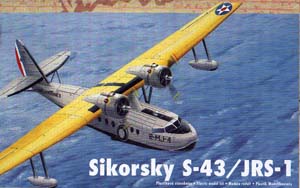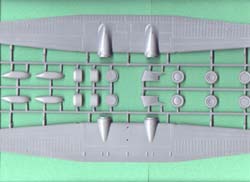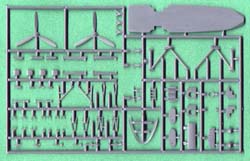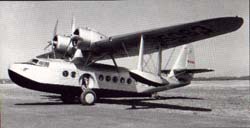Sword 1/72 Sikorsky S-43 Baby Clipper |  | History Pan American Airways' founder and president, Juan Terry Trippe, commissioned Sikorsky to design the S-43 in 1934. These twin-engine, 18 passenger, "Baby Clipper" amphibians were designed for coastal and other routes in the Caribbean and in Central and South America. The first and second airplanes, however, went to Inter-Island Airways, Ltd, (now Hawaiian Airlines) in 1935. Inter-Island later took delivery of two more S-43s. Pan American ordered a total of twelve S-43's; one source, though, says the total was 13. Of these Pan Am, themselves, operated only three; the balance going to subsidiaries Pan Air do Brazil (7) and Pan American-Grace Airways, Inc. - PANAGRA - (2). After a crash, Pan Am's c/n 4316 (NC-16927) was rebuilt, using parts from crashed c/n's 4307 and 4308, as a twin-tailed S-43B. William Vanderbilt and Howard Hughes each ordered S-43's for personal use. Vanderbilt's was fitted out, and used, as a "Flying Yacht"; Hughes' was fitted with extra fuel tanks and radio/navigation gear for a round-the-world record attempt. Hughes later had his NX-440 rebuilt in the twin-tailed S-43B configuration and thereupon crashed it in Lake Mead. The record attempt was never made with the Sikorsky but Hughes did break Wiley Post's record in a Lockheed L-14 "Super Electra" in July 1938. The U.S. Army bought seven as OA-8s and the U.S. Navy bought five as JRS-1s; some of the Navy's were allocated to the U.S. Marine Corps and to the U.S. Coast Guard. Another buyer was China National Aviation Corporation (CNAC), of which Pan Am owned 45%. CNAC allocated one of these to Madame Chiang Kai-Shek for her personal use as head of the Chinese Air Force. Aeromaritime, of France, operated S-43s in West Africa. Other airlines operated them in Norway, the Philippines and in The Soviet Union. That I am aware only two of this type survive; one is the Hughes airplane recovered and restored to its original single-tail S-43 configuration and fitted out, and used, as a "Flying Yacht". The other is an unrestored ex-navy JRS-1 in the collection of the US National Air and Space Museum. The Kit It's a beauty! And, it's big; wingspan is 14 5/16" (385 mm). And it comes in a precedent setting - I hope - relatively stout, lidded box. By my count, the kit contains 161 parts. 113 are crisply injection molded, with no more flash than a typical Tamigawagram kit, in a medium-grey polystyrene. There are no mold release ejector-pin marks anywhere that they will ever be seen on the finished model. The review sample had only two tiny, easily filled sink marks between the 3rd and 4th cabin windows on the left side. 25 detail parts - engines, seats, etc. - are cast in polyurethane resin that is the same medium-grey color as the polystyrene parts. These resin parts are very finely detailed. 23 parts injection molded in clear polystyrene comprise the windscreen/cockpit side windows and cockpit roof, 20 cabin windows and two landing light lenses. Engineering and assembly of the kit are quite conventional with a minor exception in the fuselage. There are the usual vertically split halves but, in order to provide the requisite detail atop the forward fuselage this area is molded as two separate halves that are installed after the interior of the fuselage is detailed. The clear part for the windscreen and cockpit side windows also includes the cockpit roof in order to provide crisp detail for the pilots' escape hatches. The interior is well provided with detail but the windows are all so small that none of it can really be seen unless you pose open the aft entry hatch atop the rear fuselage and the two pilots' escape hatches. Don't open the forward entry hatch for that would reveal that the forward fuselage compartment is not detailed at all. One quirk in the engineering of the kit parts is that 7/8" (22 mm) of each wing tip is molded separately. The only reason that I can imagine for this is to make the wing fit the box! I am quite impressed with the level of detail provided by the myriad parts that make up the undercarriage. One detail not included in the kit is the RDF antenna "Football" fairing frequently seen on S-43's. Optional parts provide for exposed or capped wheels, main entry hatch open or closed and wheels up or down Big olde complaint: 53 Baby Clippers were built; only 12 went to the military, yet the only markings offered in the kit are for a JRS-1 of the U.S. Marine Corps and for another of the U.S. Navy. The decal sheet itself is sharply printed in perfect register and looks dense enough for the white of the insignia to be opaque when applied. I hope the Editor prints the scan that I sent him of a Pan American Baby Clipper to offset this militaristic bent. The 20 page (five folded A4 sheets) instruction booklet provides a brief history - in English only - a parts map, a 21 step assembly sequence and four pages of detailed drawings showing the two color schemes provided for by the decal sheet. The very small amount of rigging required on this plane is well presented in these instructions. IPMS-Seattle member Bill Johnson bought this kit in mid-May at Hannant's in Colindale enroute to visit the RAF Museum at Hendon. He paid 16.95 Sterling - about US$24.50 - for it there. Our local connection, Emil Meinerich, owner of Skyway Model Shop expects the US retail to be about $42.00. Thanks to Bill for loan of the kit for this review. I don't want to give it back. Conclusion A fine kit of a great subject. Buy at least one for your collection of "Golden Age" airplanes. Heaps of kudos to Sword for their continuing brave, bold choice of subjects. Dear Messrs. Sword: May we, good sirs, have a Lockheed L-14 "Super Electra" and an L-18 "Lodestar" - both with a selection of civil markings - sometime in the future? References -
Pan Am, An Airline and its Aircraft: R.E.G. Davis & Mike Machat, Hamlyn, Twickenham, 1987, ISBN: 0-600-556719. -
The Pan Am Clipper - The History of Pan American's Flying Boats 1931 to 1946: Roy Allen, Barnes & Noble, 2000, ISBN: 0-7607-2187-4. -
The Aircraft Treasures of Silver Hill: Walter J. Boyne, Rawson, New York, 1982, ISBN: 0-89256-216-1. -
Flight Journal, February 1999: Feature article by Budd Davisson. -
Skyways Quarterly No. 21. -
Skyways Quarterly No. 22. -
Skyways Quarterly No. 32. -
Skyways Quarterly No. 35. -
Aeroplane Monthly April 1996. | 








|















